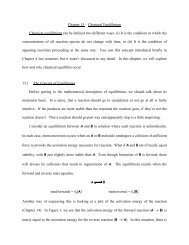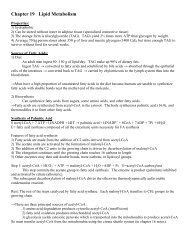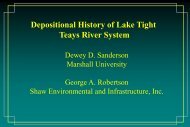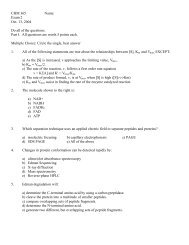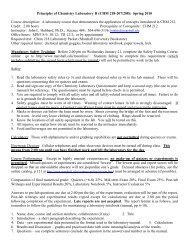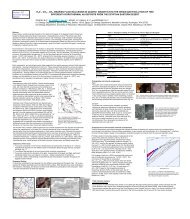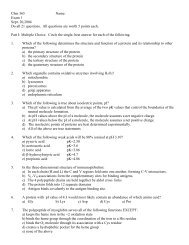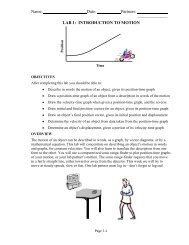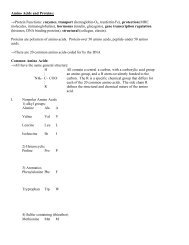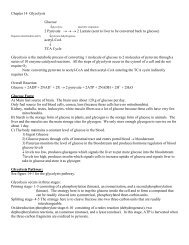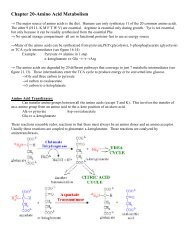CytoTox 96(R) Non-Radioactive Cytotoxicity Assay Technical ...
CytoTox 96(R) Non-Radioactive Cytotoxicity Assay Technical ...
CytoTox 96(R) Non-Radioactive Cytotoxicity Assay Technical ...
You also want an ePaper? Increase the reach of your titles
YUMPU automatically turns print PDFs into web optimized ePapers that Google loves.
VII. Troubleshooting (continued)<br />
Symptoms<br />
Low overall absorbance values<br />
Low value for Target Cell<br />
Maximum Release<br />
Causes and Comments<br />
Plate reader set at incorrect absorbance. Set<br />
plate reader to 490 or 492nm and repeat<br />
absorbance readings.<br />
Substrate degraded by light. Check that the<br />
substrate preparation and LDH reaction<br />
(Section V.C, Steps 2 and 3) are performed<br />
while protected from light.<br />
Target cell number not optimized. Optimize the<br />
number of target cells added to the assay<br />
(Section IV).<br />
VIII. References<br />
1. Nachlas, M.M. et al. (1<strong>96</strong>0) The determination of lactic dehydrogenase with a<br />
tetrazolium salt. Anal. Biochem. 1, 317–26.<br />
2. Korzeniewski, C. and Callewaert, D.M. (1983) An enzyme-release assay for natural<br />
cytotoxicity. J. Immunol. Meth. 64, 313–20.<br />
3. Decker, T. and Lohmann-Matthes, M.L. (1988) A quick and simple method for the<br />
quantitation of lactate dehydrogenase release in measurements of cellular cytotoxicity<br />
and tumor necrosis factor (TNF) activity. J. Immunol. Meth. 115, 61–9.<br />
4. Brander, C. et al. (1993) Carrier-mediated uptake and presentation of a major<br />
histocompatibility complex class I-restricted peptide. Eur. J. Immunol. 23, 3217–23.<br />
5. Behl, C. et al. (1994) Hydrogen peroxide mediates amyloid beta protein toxicity. Cell<br />
77, 817–27.<br />
6. Lappalainen, K. et al. (1994) Comparison of cell proliferation and toxicity assays using<br />
two cationic liposomes. Pharm. Res. 11, 1127–31.<br />
7. Allen, M.J. and Rushton, N. (1994) Use of the <strong>CytoTox</strong> <strong>96</strong> <strong>Assay</strong> in routine<br />
biocompatibility testing in vitro. Promega Notes 45, 7–10.<br />
8. Sinensky, M.C., Leiser, A.L. and Babich, H. (1995) Oxidative stress aspects of the<br />
cytotoxicity of carbamide peroxide: in vitro studies. Toxicol. Lett. 75, 101–9.<br />
9. Moravec, R. (1994) Total cell quantitation using the <strong>CytoTox</strong> <strong>96</strong> <strong>Non</strong>-<strong>Radioactive</strong><br />
<strong>Cytotoxicity</strong> <strong>Assay</strong>. Promega Notes 45, 11–12.<br />
10. Singer, C.A. et al. (1999) The mitogen-activated protein kinase pathway mediates<br />
estrogen neuroprotection after glutamate toxicity in primary cortical neurons. J.<br />
Neurosci. 19, 2455–63.<br />
11. Miroslav, C. et al. (1995) Using Promega’s <strong>CytoTox</strong> <strong>96</strong> ® <strong>Non</strong>-<strong>Radioactive</strong> <strong>Cytotoxicity</strong><br />
<strong>Assay</strong> to measure cell death mediated by NMDA receptor subunits. Promega Notes 51,<br />
21–22.<br />
12. Gorman, C.M., Gies, D.R. and McCray, G. (1990) Transient production of proteins<br />
using an adenovirus transformed cell line. DNA Prot. Eng. Technol. 2, 3.<br />
Promega Corporation · 2800 Woods Hollow Road · Madison, WI 53711-5399 USA<br />
Toll Free in USA 800-356-9526 · Phone 608-274-4330 · Fax 608-277-2516 · www.promega.com<br />
Part# TB163<br />
Printed in USA.<br />
Page 16 Revised 3/06



